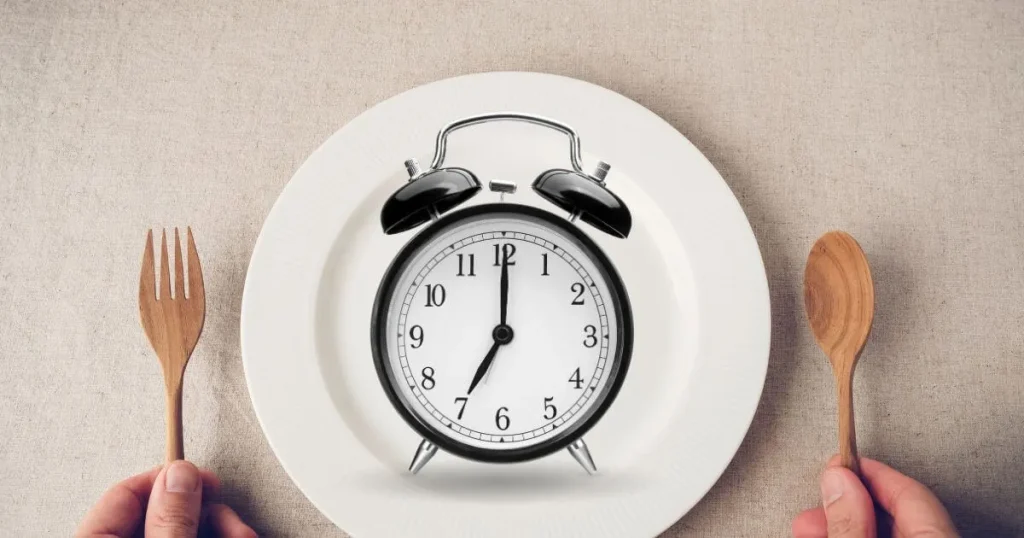Intermittent fasting (IF) has become a popular way to improve health and lose weight. Unlike traditional diets, intermittent fasting doesn’t tell you what foods to eat, but rather when to eat them. Many people find this approach easier due to its flexibility and offering great results. Intermittent fasting can help the body use its stored energy better, leading to benefits like fat loss and increased energy levels. This guide will explain everything, you need to know about intermittent fasting, especially if you’re a beginner looking for a simple but effective approach.
Table of Contents
Intermittent Fasting Guide
What is Intermittent Fasting?
Intermittent fasting is an eating pattern where you alternate between periods of eating and fasting. It’s about when to eat instead of skipping meals or starving yourself. Intermittent Fasting offers different methods to follow to get the required results. These methods are based on only one basic rule: eat during specific hours and fast for the rest.
For example, with the 16/8 method, you eat all your meals in an 8-hour window and fast for the other 16 hours. This gives your body a break from constantly processing food, allowing it to focus on other important tasks like burning fat or repairing cells. During fasting, your body switches from burning sugar for energy to burning stored fat, which is one reason many people lose weight with this method.
Intermittent fasting isn’t just about weight loss; it also improves your overall health. This type of fasting is based on the idea, that our ancestors didn’t always have access to food, so their bodies adapted to go long periods without eating. Intermittent fasting mimics this natural eating pattern, which may explain why it works so well for some people.
Benefits of Intermittent Fasting
Intermittent fasting offers several benefits ranging beyond just losing weight. Let’s take a closer look at some of the main advantages:
1.Hassle-free way of weight Loss and Fat Burning
One of the biggest reasons people try intermittent fasting is for weight loss. By eating during a shorter time frame, you naturally consume fewer calories. Fasting also helps your body burn stored fat because it runs out of sugar to use for energy. This can lead to gradual, sustainable weight loss without the need for strict calorie counting or complicated diets.
2.Helps improving Metabolism
Fasting can boost your metabolism by lowering insulin levels and increasing human growth hormone (HGH) levels. Lower insulin helps your body break down fat more efficiently, while higher HGH levels help with muscle growth and repair. This combination can make you feel more energized and improve your body’s ability to manage food.
3.Beneficial to brain function
Intermittent fasting may also benefit your brain. Studies suggest that fasting increases the production of a protein called brain-derived neurotrophic factor (BDNF). This protein supports the health of your brain cells and may help with learning and memory. Many people who practice intermittent fasting report feeling more focused and clear-headed, especially during fasting hours.
4.Friendly to longevity and disease prevention
According to some studies, intermittent fasting may help you live longer. Fasting reduces inflammation and promotes cellular repair, which can help protect your body from diseases like heart disease, cancer, and Alzheimer’s. While more research is needed, the early results are promising for anyone looking to improve their long-term health.
5.Simple, flexible, and user-friendly
Being user-friendly, simple, and easy, intermittent fasting doesn’t involve complicated meal plans or strict food rules. You can choose a fasting schedule that works for your lifestyle, making it easier to stick with than traditional diets. Plus, you don’t need to count calories or cut out entire food groups, which can make the process feel less restrictive.
Types of Intermittent Fasting Plans
Intermittent fasting (IF) offers several plans, each with its own approach. These plans differ in how long you fast and how long you eat. Picking the right one depends on your lifestyle and personal goals.
16/8 Method
This is one of the most popular methods. You fast for 16 hours, and then you eat during an 8-hour window. For example, if you eat your first meal at 12:00 p.m., you stop eating by 8:00 p.m. During the fasting hours, only water, tea, or black coffee are allowed. Many people find this method easier because it fits into their regular schedule, like skipping breakfast but eating lunch and dinner.
5:2 Diet
In the 5:2 diet method, you are supposed to eat normally for five days in a week. On the other two days, you reduce your calorie intake to about 500-600 calories. These two days don’t have to be back-to-back. The idea is to let your body rest from food but still get some energy on fasting days.
Eat-Stop-Eat method
This plan involves fasting for a full 24 hours, once or twice a week. For example, if you finish dinner at 7:00 p.m., you won’t eat again until 7:00 p.m. the next day. This method can be a bit harder, but it helps to reset your body.
Alternate Day Fasting (ADF)
With this plan, you alternate between eating and fasting days. On fasting days, you either eat very little (around 500 calories) or nothing at all. On eating days, you eat normally. While this can be challenging, it may lead to faster weight loss.
The Warrior Diet
The Warrior Diet method involves fasting for 20 hours and eating all your calories in a 4-hour window. During the 20-hour fast, you can have small snacks like raw fruits or vegetables. In the eating window, you focus on one large meal.
Each fasting plan comes with different benefits and challenges. It’s important to choose the one that fits your routine best.
How to Start Intermittent Fasting as a Beginner
Starting intermittent fasting doesn’t have to be difficult. By taking small steps, and making gradual changes, you can easily build up to longer fasting periods.
1. Choose the Right Fasting Plan
Look at the different types of intermittent fasting and choose the one that fits best for you. If you’re new to fasting, the 16/8 method is a good start. It lets you skip breakfast but still enjoy lunch and dinner.
2. Set Realistic Goals
It’s important to start small. Don’t jump into a 24-hour fast right away. Set simple goals, like fasting for 12 hours and eating for 12 hours, and work your way up. Track your progress and how your body feels as you adjust.
3. Start Slow
If fasting for long periods sounds tough, start with shorter fasts and gradually increase the time. For example, try fasting for 12 hours and then extend it by one hour each week until you reach your desired goal.
4. Stay Hydrated
While fasting, drink plenty of water to keep your body hydrated. You can also drink herbal teas or black coffee, as these don’t break your fast. Staying hydrated will also help reduce hunger.
5.Eat Mindfully During Eating Windows
When it’s time to eat, focus on healthy and balanced meals. Include lots of vegetables, lean proteins, and healthy fats. This will help you feel full longer and keep your energy up during fasting.
By starting slow and observing your body, you can make intermittent fasting a part of your routine without stress.
Common challenges and their solutions
When you start intermittent fasting, you may face some challenges. Luckily, there are certain ways to overcome them and make fasting easier.
1. How to manage hunger pangs?
Feeling hungry is common, especially when you’re new to fasting. To manage hunger:
- Stay hydrated: Sometimes thirst is mistaken for hunger. Drink water throughout the day.
- Eat high-fiber foods: Fiber-rich foods like vegetables, beans, and whole grains help keep you full longer.
- Distract yourself: Stay busy during fasting hours to take your mind off food.
2. Low Energy and Fatigue
In the beginning, you might feel tired. This happens as your body adjusts to fasting. To fight fatigue:
- Eat nutrient-dense foods: Make sure you’re eating balanced meals with enough nutrients. This will help keep your energy up during fasting.
- Get enough sleep: Rest is important when your body is adapting to a new routine. Manage your sleep for 7-8 hours each night.
3. Handling the social situations
Social events can make fasting hard, especially when there’s food around. To handle these situations:
- Plan ahead: If you know you’ll be at a party, adjust your fasting window so you can eat with everyone.
- Choose wisely: If you can’t adjust your fast, opt for small portions of healthier foods and drink water.
4. Cravings
Cravings can strike while fasting, making it hard to stay on track. To beat cravings:
- Focus on nutrient-rich foods: Eating whole foods during your eating window will reduce cravings during fasting.
- Chew sugar-free gum: This can help curb cravings without breaking your fast.
5. Sleep Issues
Some people have trouble sleeping while fasting. If you’re struggling with sleep:
- Eat earlier: Try not to eat too close to bedtime. This gives your body time to digest.
- Relax before bed: Create a calming bedtime routine to help you fall asleep.
By facing these challenges head-on, you can make intermittent fasting smoother and more enjoyable.
What to Eat During Eating Windows
When it’s time to eat during intermittent fasting, choose foods that nourish your body. You want to make the most of the time when eating by filling your meals with healthy, nutrient-rich foods. This helps you feel satisfied and gives you the energy to stay on track.
Focus on Nutrient-Dense Foods
The best foods to eat are those packed with vitamins, minerals, and nutrients that help your body stay strong. Think of foods like:
- Lean Proteins: Chicken, turkey, eggs, and fish can keep you full longer and help with muscle repair.
- Healthy Fats: Avocados, nuts, seeds, and olive oil give you energy and support brain function.
- Whole Grains: Brown rice, quinoa, and oats provide fiber and help you feel fuller for longer.
- Vegetables and Fruits: These should be a big part of your meals because they are rich in vitamins and low in calories. Broccoli, spinach, berries, and apples are great choices.
Best Foods to Break Your Fast
After fasting, your body needs something easy to digest but still nutritious. Start with a small meal to avoid overwhelming your stomach. Try foods like:
- Smoothies: A mix of fruits, veggies, and a protein source like yogurt or protein powder.
- Soup or Salad: These are light yet filling options that won’t weigh you down.
- Boiled Eggs and Whole Grain Toast: A simple meal that’s balanced and easy to digest.
Foods to Avoid
While it might be tempting to eat anything once the fasting window ends, try to avoid processed foods or sugary snacks. Junk food can make you feel tired and reduce the benefits of intermittent fasting. Stick to whole, unprocessed foods whenever possible.
Intermittent Fasting and Exercise
Taking Exercise while intermittent fasting seems tricky, nonetheless, it is possible to stay active even without feeling too tired. Knowing when and how to work out during fasting is key to balancing both without overworking your body.
Exercising While Fasting
It’s safe to exercise during fasting, but you need to adjust your intensity. Light activities like walking, yoga, or stretching are great during fasting hours. For more intense workouts, like weightlifting or running, some people prefer to eat beforehand for energy.
Choose the best time to work out
The best time to exercise often depends on how you feel. Many people prefer to work out just before their eating window opens. This way, they can refuel their bodies with a nutritious meal right after exercising. Others find that exercising during their fasting window helps burn more fat, especially with low-intensity activities like walking.
Combination of Fasting and Exercising
Combining intermittent fasting with exercise can lead to improved fat loss and muscle tone. Fasting encourages your body to burn stored fat, and exercising enhances this effect. However, it’s important to listen to your body. If you feel dizzy or weak, lower the intensity or eat a small snack before exercising.
Who Should Avoid Intermittent Fasting?
While intermittent fasting has many benefits, it’s not for everyone. Some people may experience negative effects, so it’s important to know if it’s the right choice for you. Here are groups of people who should avoid or be careful with this fasting.
Consider your Health Conditions
People with certain health issues, like diabetes or low blood sugar, should not try intermittent fasting without consulting a doctor. Fasting can affect insulin and blood sugar levels, which could lead to dangerous complications for people with these conditions. You should consider your health conditions before assuming intermittent fasting.
Pregnant and Breastfeeding Women
Pregnant or breastfeeding women are advised to choose more nutrients to support both their health and their baby’s growth. Intermittent fasting may limit the nutrients they get, so it’s usually not recommended during these phases of life.
People with Eating Disorders
People with a history of eating disorders, like anorexia or bulimia, should avoid intermittent fasting. The focus on controlling eating times might trigger unhealthy behaviors, so it’s better to stick to a regular, balanced eating routine.
If you have any doubts or existing health concerns, always consult a healthcare professional before starting intermittent fasting.
Intermittent fasting can be a powerful tool for improving your health, managing weight, and boosting energy levels. As a beginner, it’s important to approach it with patience and consistency. Start with a method that fits your lifestyle, and remember to focus on eating nutritious foods during your eating windows.
Make sure to listen to your body. If you feel tired or unwell, adjust your fasting routine or consult a doctor. Intermittent fasting isn’t a one-size-fits-all solution, but with the right approach, it can be an effective way to reach your health goals.
Frequently Asked Questions (FAQs) about Intermittent Fasting
1. How long does it take to see results with intermittent fasting?
The time it takes to see results varies for everyone. Some people notice changes within a few weeks, while others might take longer. It depends on your body type, eating habits, and fasting schedule. Typically, most people see improvements in weight loss and energy levels after about 4 to 6 weeks. It’s important to stay consistent and give your body time to adjust. If you follow a balanced diet during your eating windows and stick to your fasting routine, you’ll likely see steady progress over time.
2. Is intermittent fasting safe for women?
Yes, intermittent fasting can be safe for women, but they may need to adjust their approach. Some women might experience hormonal imbalances if they fast for too long or too often. They can start with shorter fasting periods, like the 12/12 method (12 hours of fasting, 12 hours of eating). Women should avoid extreme fasting methods and ensure having nutrient-dense meals during their eating windows. If you’re pregnant, breastfeeding, or have a history of menstrual issues, it’s best to consult a doctor before starting intermittent fasting.
3. Can I still build muscle while intermittent fasting?
Yes, you can build muscle while following intermittent fasting, but it requires careful planning. It’s essential to eat enough protein during your eating window to support muscle growth. Incorporating strength training exercises will also help build and maintain muscle. Many people find success by scheduling their workouts during or right before their eating window, so they can refuel their bodies with nutrients after exercising. Combining intermittent fasting with the right workout and nutrition plan can lead to both fat loss and muscle gain.
4. What if I feel dizzy or weak during fasting?
These symptoms often occur at the beginning stage, when your body is adjusting to a new eating pattern. You need to stay hydrated by drinking plenty of water throughout the day. You might also feel weak if you’re not eating enough nutrients during your eating window. Focus on balanced meals with whole grains, lean proteins, and healthy fats to fuel your body properly. If dizziness continues, consider shortening your fasting window or speaking with a healthcare professional to ensure fasting is safe for you.
5. Is intermittent fasting the same as starvation?
No, intermittent fasting is not the same as starvation. Fasting involves controlled periods of not eating, while starvation is a lack of access to food for long periods. With intermittent fasting, you still get all the nutrients your body needs during your eating windows. Fasting is done in a structured way to improve health, while starvation is harmful and unsafe. The goal of intermittent fasting is to improve your body’s metabolism and health, not to deprive it of nutrients.
6. Can I take supplements while fasting?
Yes, you can take supplements while fasting, but it’s important to know which ones may affect your fast. Some supplements, like multivitamins, may contain calories or sugars that could break your fast. Others, like water-soluble vitamins (Vitamin C, B12), electrolytes, or plain minerals, can be taken without breaking your fast. If your supplements require food for better absorption, it’s best to take them during your eating window. Always check the labels of your supplements and consult a healthcare professional if you’re unsure.
- The Complete Intermittent Fasting Guide for Beginners - September 11, 2024
- Blue Lotus Flower: Unlocking the Benefits, Uses and Safety - April 25, 2024
- How To Get Enough Protein On A Plant-Based Diet - April 5, 2024



